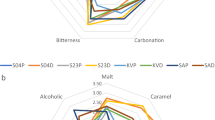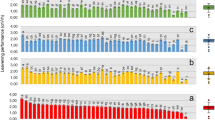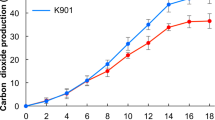Abstract
ESTERS are supposed to be of importance as flavour determinants in many products. A considerable number of esters have been detected in fruits1–8 and in fermented beverages9–11. Jennings4 has shown that the desirable pear aroma is largely due to volatile esters. Esters are also used in essences (primarily the esters with 6–8 carbon atoms in acid + alcohol)1,7 and are generally accepted to be important contributors to the flavour and aroma of beer and wine. The threshold concentration for flavour perception is very low for some esters: it is 0.01 p.p.m. for ethyl isobutyrate, for example, as has been reported by Harrison12. Sihto and Arkima13 have reported that isopentyl acetate is deleterious to the flavour of berr at rather low concentrations.
This is a preview of subscription content, access via your institution
Access options
Subscribe to this journal
Receive 51 print issues and online access
$199.00 per year
only $3.90 per issue
Buy this article
- Purchase on Springer Link
- Instant access to full article PDF
Prices may be subject to local taxes which are calculated during checkout
Similar content being viewed by others
References
Burger, A. M., Buch der Aromen, second ed. (W. Williger, Wädenswil, 1955).
Connell, D. W., Austral. J. Chem., 17, 130 (1964).
Hultin, H. O., and Proctor, B. E., Food Technol., 15, 440 (1961).
Jennings, W. G., J. Food Sci., 26, 564 (1961).
Jennings, W. G., and Creveling, R. K., J. Food Sci., 28, 91 (1963).
McCarty, A. I., Palmer, J. K., Shaw, C. P., and Anderson, E. E., J. Food Sci., 28, 379 (1963).
Meyer, L. H., Food Chemistry, 162 (Reinhold Publishing Co., New York, 1960).
Nishimura, K., and Hirose, Y., Agric. Biol. Chem., 28, 1 (1964).
Lawrence, W. C., Wallerstein Lab. Commun., 21, 123 (1964).
Stevens, R., J. Inst. Brewing, 66, 453 (1960).
Webb, A. D., and Ingraham, J. L., Adv. App. Microbiol., 5, 317 (1963).
Harrison, G. A. F., European Brewery Conv. Proc. Congr., 247 (Brussels, 1963).
Sihto, E., and Arkima, V., J. Inst. Brewing, 69, 20 (1963).
Nordström, K., Svensk Kem. Tidskr., 76, 510 (1964).
Nordström, K., J. Inst. Brewing, 70, 328 (1964).
Nordström, K., J. Inst. Brewing, 70, 42 (1964).
Nordström, K., J. Inst. Brewing, 69, 142 (1963).
Nordström, K., J. Inst. Brewing, 69, 310 (1963).
Nordström, K., J. Inst. Brewing, 67, 173 (1961).
Nordström, K., J. Inst. Brewing, 68, 398 (1962).
Åyräpää, T., Holmberg, J., and Sellman-Persson, G., European Brewery Conv. Proc., Congr., 286 (Vienna, 1961).
Author information
Authors and Affiliations
Rights and permissions
About this article
Cite this article
NORDSTRÖM, K. Formation of Esters from Acids by Brewer's Yeast: Formation from Unsaturated Acids. Nature 210, 99–100 (1966). https://doi.org/10.1038/210099a0
Issue Date:
DOI: https://doi.org/10.1038/210099a0
This article is cited by
-
Comprehensive Real-Time Analysis of the Yeast Volatilome
Scientific Reports (2017)
Comments
By submitting a comment you agree to abide by our Terms and Community Guidelines. If you find something abusive or that does not comply with our terms or guidelines please flag it as inappropriate.



